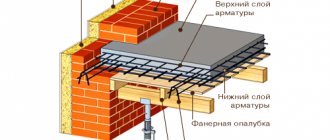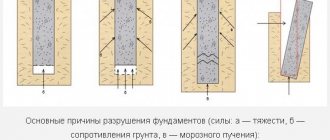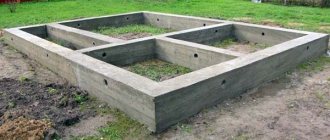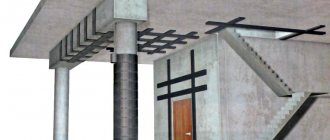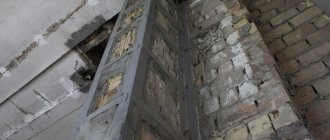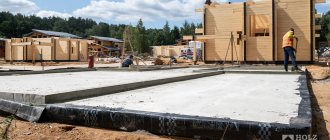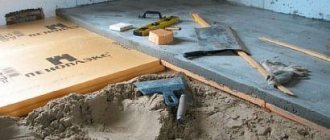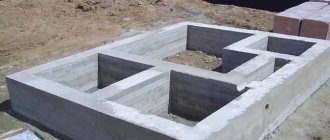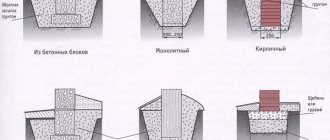Narrative plan:
- Introduction;
- Reasons for drawdown;
- Preparatory stage;
- Amplification technology;
- Work order;
- Increasing the width of the sole.
Special reinforcement of a collapsing rubble foundation or concrete strip under a building is a common practice to avoid wall collapse and subsidence. The use of reinforced concrete structures allows you to quickly increase the area of the sole, achieving uniform load distribution.
Strengthening the foundation with piles
There are many types of piles that can be used to strengthen the foundation.
Bored injection piles
You can add additional strength to the structure using drilled injection piles. Recently, this technique has enjoyed considerable popularity. But due to the use of innovative technologies, expensive materials, drilling equipment and the involvement of specialists, this method is considered quite expensive.
The essence of the technology is as follows:
- Several inclined wells with a diameter of 15–25 cm are drilled from two or four sides of the old foundation (depending on the individual characteristics of the foundation and the house). The wells are deepened all the way into the hard rock. They should be located on the outer and inner sides of the base at a distance of 1.5 m from each other.
- Cement or high-strength concrete is poured into the resulting holes and a reliable steel reinforcement frame is laid.
- The structure is attached to the base using anchors.
After the solution dries, a new foundation of pile structures is formed, which in strength and reliability resembles the monolith on which the structure is based.
You can add additional strength to the structure using drilled injection piles
Micropiles
In some cases, micropiles are used. Their diameter is 150–300 mm. During the drilling process, you can fill the wells with solution. This method involves the use of drill rods. Remaining inside the pile, they provide more reliable strengthening of the foundation.
With the help of micropiles you can strengthen not only the foundation, but also the soil
Video: strengthening the foundation with micropiles
Indentation piles
To transfer loads to hard, deep soils, indented piles are used. They are installed using special equipment. Beams mounted into the base ensure good connection between the foundation and piles.
Video: strengthening the foundation with indented piles
External piles
The method of strengthening the foundation with external piles is used when the groundwater level is high. The foundation is placed on piles. The connecting link between the piles and the foundation is a reinforced concrete beam passed through the foundation.
The foundation is placed on piles
Metal tubular piles
Installation of metal tubular piles is carried out on both sides of the platform. For this, a welding method is used using special equipment. To install the piles, a reinforced concrete frame is mounted and connected to beams supported by jacks.
Metal piles are connected by a reinforced concrete beam
Preparatory work before strengthening the foundation
Preparation for strengthening the foundation is divided into 2 stages - examination of the foundation and its unloading.
Foundation survey
Inspection of the foundation of a building can be planned (periodic inspection so as not to miss the beginning of destruction) and unscheduled. The latter is carried out:
- in case of distortions in the openings or cracks in the walls;
- if there are doubts about the correct laying of the foundation in accordance with the standards and rules;
- when an old building requires reconstruction or there is a need to increase the number of storeys of the house;
- when purchasing a plot of land with the construction of a house already begun;
- when it is noticed that there is a regular presence of water in the basement;
- if foundation subsidence is visually detected;
A visual inspection shows how the subsidence of the foundation led to its destruction. Now we need appropriate measures not only to compact the soil, but also to strengthen the entire foundation structure - if it is necessary to install additional production capacity, which will significantly increase the pressure on the base;
- with physical and moral deterioration of the foundation.
The study is carried out differently depending on the approach to the constituent elements of the structure and the magnitude of the destruction. The easiest way is to carry out a visual inspection and record the detected flaws in a photo or video in order to observe the defects.
External inspection is done in easily accessible, clearly visible places without any tools. They mainly inspect the pits, the upper surface of the base, its base and grillage. Pay attention to corrosion of concrete, reinforcement exposed due to chips, destruction of masonry, the appearance of gaps, rust and cracks, and violation of the integrity of the monolith.
A visual inspection is usually carried out during the day, but it does not give such clear results as an instrumental examination using special equipment.
Instrumental control is necessary in the following cases:
- when the deformation area of all sections exceeds 10% in total;
- if the spatial arrangement of the structure is violated (this may be a tilt, shift or settlement);
- if the chip depth reaches 1.5 cm.
Before strengthening a reinforced concrete foundation, it is first determined whether its shrinkage has stopped - beacons are installed across the cracks and observed for a month. If no changes are found, strengthening work begins.
Unloading the foundation
This is the final, but very important stage of the preparatory work, since it allows you to prevent distortions when strengthening the foundation. Yes, and interfering with the structural basis of any structure without redistributing the load completely or partially onto temporary structural supports is fraught with destruction of it as a whole.
Partial unloading (redistribution) is carried out using temporary wooden supports, as well as metal or wooden struts. In the underground room or on the lower floor of the house, at a distance of about 2 m from the wall partitions, support pillows are laid, and on top of them - a beam with racks. The upper purlin is attached to the posts with anchors (as shown in the figure). After this, wedges are driven in between the supporting lower beam and the uprights, transferring the load from the floors to temporary supports.
Scheme of partial unloading of the foundation using temporary wooden supports: 1 - foundation, 2 - walls, 3 - floors, 4 - upper girder, 5 - rack, 6 - wedges, 7 - support beam, 8 - support pad
Complete unloading of the base is done using foundation beams (they are called rund beams) or transverse and longitudinal beams made of reinforced concrete or metal:
- Redistribution of load using beams, which are embedded in the wall masonry.
On both sides of the wall, under the bonded row of brickwork, grooves are pierced. Rand beams are fixed in them and every 1.5 or 2 m in a horizontal plane they are tightened with bolts Ø 20–25 mm. The gap between the wall partition and the rand beam is compacted with cement-sand (1:3) mortar. The joints of the rand beams are connected with overlays using electric welding. Scheme of complete unloading of foundations using: a) rand beams and b) transverse beams: 1 - foundation, 2 - wall, 3 - groove, 4 - rund beam, 5 - tie bolt, 6 - through hole, 7 - transverse beam, 8 - longitudinal beam, 9 - support pad - Redistribution of gravity using transverse (horizontal) beams. At the bottom of the brick partition, near the upper edge of the base, through holes are made every 2–3 m and beam structures are inserted into them. Under each of the beams, support pads are placed on both sides on a compacted base. It is to them that the load is transferred through the installed longitudinal beams using pegs. If the wall is in poor condition, then first strengthen it by installing rand beams above the through holes.
What to do if the foundation is cracked
The problem of a crack that has appeared in the base can be eliminated in different ways, it all depends on the material used in construction.
The main reason for the appearance of cracks in masonry is shrinkage of the structure or moving soil. In this case, digging to create a cushion cannot be carried out, so you can strengthen the foundation of a house that has already been built using a concrete belt.
For a wooden structure, you can use the pile method.
When using piles, you must remember that they must reach solid ground, otherwise they will sag under the weight of the house.
If cracks appear in a monolithic building, the reinforcement options described above will not be suitable. Here you will need to completely replace the stove.
Ways to strengthen the foundation of a house
Builders have a wide range of tools and methods to strengthen the foundation of an old house. At the same time, time-tested methods do not lose their relevance. To choose the most optimal one, it is necessary to understand the advantages and disadvantages of each of them in relation to a specific case.
Ways to strengthen the foundation
Strengthening the strip foundation
The foundation of most private houses is a strip foundation. The characteristics of such foundations have the technical possibility of locally exceeding the normative loads. This type of foundation may experience local soil heaving. All types of foundations are built on bedded stone
When it draws down, it is important to stop this process in a timely manner.
Strengthening strip foundations
To do this, a hole is dug at an angle of 35 degrees in close proximity to the foundation. Its depth should reach the level of laying the bed stone. Then a pipe with a diameter of 150-200 mm is placed in the resulting hole. With its help, a thin concrete solution is poured, which is continued until the soil is completely saturated with it. At this stage, it is necessary to suspend all work for a couple of hours. At this time, observation should be made of the behavior of the soil in terms of saturation with the solution.
If the solution leaves, then continue filling the hole after a few days.
As practice shows, to completely saturate the soil, the procedure must be repeated two or three times. Control over the situation is carried out by beacons. In case of a slight change in their position, they move on to the next stage.
A ditch with a width of 200-350 mm is dug along the contour of the foundation. At its bottom and on the outside, a structure similar to formwork is constructed from boards. Pins are driven into the foundation, and a reinforcing mesh is attached to them. The resulting reinforcement is filled with concrete mortar filled with fine gravel and crushed stone. Such a structure will make it possible to significantly strengthen this corner of the house and evenly distribute the loads in the horizontal plane, which will stop the process of subsidence of the house.
Restoration of a foundation with cracks
Crack formation in the base and distortion of load-bearing structures can be of a different nature. Therefore, the first priority is to find out the nature of the processes taking place in order to find an adequate way to strengthen the foundation of the house.
Restoration of a foundation with cracks
If there is destruction along the perimeter of the foundation due to increased loads or exposure to moisture, a trench is dug that follows its contours. After this, the surface is thoroughly cleaned to remove the layer of plaster and adhering dirt. Next, the metal mesh is fixed with anchors driven into the base. Finally, the concrete solution is poured layer-by-layer with careful compaction.
If the foundation material is rubble stone, a monolithic slab of concrete or combinations of concrete-based materials, then a widened reinforced concrete frame is used. In this case, it is necessary to carry out reliable fixation, using through anchoring, with the old masonry material. The idea of building such a structure is that the old and new foundations work as a single whole.
Partial foundation replacement
If the foundation fails completely, it becomes necessary to replace it. To accomplish this task, it is completely unloaded, and at the same time the stability of the structure is preserved.
Unloading
This activity can be accomplished by installing so-called chairs, which are made of wood. Their installation occurs perpendicular to the foundation tracks. To secure the building, pillars placed under the walls can be used. The use of braces to hold the base and transmit forces at an angle to the ground is not excluded.
Before starting repair and restoration work, beacons should be installed. This is necessary so that the likely deformation process during this work can be detected. After this, they begin directly to implement the planned activities, which begin with digging a pit. The foundation is laid in sections, the length of which should not exceed two meters.
During excavation work, walls must be reinforced with struts. Next, a dig is made under the foundation and the soil is removed. Then the formwork and base for the foundation being constructed are installed. The sole is cleaned and, where required, dismantled. The old and new masonry are fixed together using rigid cement mortar and crushed stone. Having completed the foundation in one place, it can be continued in another.
Reasons for drawdown
The need to frame the base of the house with a reinforced concrete frame arises when the geometry of door and window openings changes. In addition to these signs, obvious subsidence of corners and cracking of walls can also be observed. They arise due to increased loads during the reconstruction of the facility.
Also among the reasons are:
- technogenic factors;
- soil leaching;
- destruction of soil structure due to frost heaving;
- weathering of layers of earth;
- lack of drainage;
- natural aging of the material.
Alumina suffers the most from such effects. When designing the foundation of a building, it is necessary to take into account possible loads from the soil and external structures. If these standards are violated, the load-bearing capacity of the tape will begin to decrease during operation.
Replacing the base
If collapse or destruction of the platform occurs in the area of the base, this part must be replaced. It is easiest to replace under a wooden structure, since it weighs less than stone or brick.
The easiest way to replace the base is under a wooden building
Under a structure made of stone or brick, the base is replaced in parts no longer than 1 m with intervals between sections of at least 3 m. To carry out the work you will need:
- fittings;
- cement;
- sand;
- crushed stone;
- plasticizer;
- concrete mixer;
- chain saw for concrete to cut out the necessary sections of the base;
- perforator;
- welding machine for fastening reinforcing elements.
How to replace the base yourself
- To install the formwork, you need to go down into the underground, so disassemble the section of the floor in the house where the foundation is strengthened.
- Make 5–10 cuts with a chain saw, maintaining a distance of 1 m between the outermost ones.
- Divide the area into small pieces with several horizontal cuts.
- Place the cut pieces aside and clean the surface of the base as well as the underside of the building.
- Build the formwork in two parts: one for the outside of the house, the other for the inside. There should be holes for reinforcement on the sides of the formwork. The formwork should be 5–7 cm wider than the wall on the outside and inside.
- Remove the prepared formwork and install the vertical pins of the reinforcing structure into holes with a diameter of 18–22 mm.
The pieces of reinforcement should rise 10–15 cm above the foundation. Attach long pieces to them. After this, weld the horizontal rods so that they coincide with the holes in the formwork. It is not recommended to connect reinforcement with tying wire, as this reduces the strength of the structure. If the base is made of reinforced concrete, the house can be raised with jacks - Install the formwork and pour the concrete using plasticizers and a minimum amount of water.
- Remove the formwork after 2 days.
- After 25 days, begin replacing adjacent sections of the base.
Video: DIY foundation repair
It is, of course, impossible to describe all technologies for strengthening foundations. Each methodology is developed individually, taking into account the results of surveys and design indicators. Owners of private housing construction need to remember that do-it-yourself strengthening work can only be carried out after a thorough inspection, receipt of examination results and relevant conclusions.
- Author: Valentina Trubich
Not ideal, but real))) Rate the article:
- 5
- 4
- 3
- 2
- 1
(4 votes, average: 5 out of 5)
Share with your friends!
Main causes of violations and ways to eliminate them
After the preliminary studies have been carried out, they begin to inspect the foundation strip in the prepared pit. This process will help to correctly answer the question of how to repair a strip foundation. Here is a list of the most common causes and ways to eliminate them.
Poor quality concrete
A very common reason for the destruction of foundations is poorly prepared concrete for pouring them. In these cases, cement shedding is observed. But this is not the only factor. A disturbance in the acid-base balance in groundwater that approaches the foundations of houses can also lead to tape scattering. To eliminate such a defect, it is necessary to begin arranging a drainage system around the foundation of a brick house and carry out work to strengthen the concrete on a monolithic strip. This is done using the cementation method, which uses a special apparatus.
- We make holes in the monolithic tapes at a certain angle, reaching a depth of up to half a meter. To prevent the foundation from bursting, the holes are placed in a checkerboard pattern in increments of up to one meter;
- We clean dust and blow it under fairly high pressure;
- at the next stage, fill them with a primer mixture for deep penetration;
- At the end of the process, the holes are filled with a special compound for strengthening.
Soil washing away
If, after constructing a pit, voids are found near the foundation structures, and after some time water appears in the recess itself, then it is necessary to equip a serious drainage system. The type of drainage system is selected depending on the amount of water approaching the monolithic foundation.
Next, we proceed to repair the monolithic structure. To do this, a waterproofing layer is installed to protect the foundation structure. Ideally, the base and base are insulated. At the end, they arrange a blind area, preferably insulated.
Stable soils are subsiding
If the strip foundation, which is built on stable soils, is cracked, the soil should be strengthened. To do this, it is necessary to drill wells and fill them with a special strengthening composition or ordinary sand-cement mortar. This procedure can be performed using pile structures. The main thing is that they are placed at the level of the sole of the base. Strengthening the foundation with piles is one of the most reliable options.
In the case when the strip foundation bursts or even certain shifts are observed, we conclude that it is laid on moving soils. To eliminate these defects, it is necessary to determine which part is sagging. Lighthouses are built for this purpose. Watch the horizontal line on the lighthouses. The part of the house with which the line is lower sags.
In these cases, they are strengthened using the pile method or the method of arranging a cement jacket is used.
Cement jacket technology
It is quite possible to strengthen the base with a cement jacket with your own hands
But please note that the main condition for extending the service life of the base is strict adherence to technology. Its essence is to expand the foundation structure in those places where the building shrinks
This method is especially relevant for shallow foundations. Here are the detailed instructions:
- Part of the sagging base is divided into segments, each of which does not exceed 2 m. Most often, three sections are obtained. Work starts from the middle;
- this part of the base is opened, but no more than to the depth of its arrangement;
- holes are drilled in the monolithic base, which are slightly smaller in diameter than the diametrical cross-section of the reinforcement used;
- steel rods are inserted into the prepared holes. The location of the holes must be at least 50 cm from each other;
- Next, the transverse rods are laid and tied, the formwork is arranged and the space is filled with mortar.
The resulting structure is allowed to stand for about two weeks. After the time has elapsed, they begin similar actions in the next section.
Preparatory stage
Regardless of whether it is planned to strengthen a rubble foundation or a concrete strip, the preliminary set of measures consists of several stages.
- Checking the condition of supporting structures.
- Investigation of cracks. Beacons are set, the stage of the subsidence process is specified.
- Soil research. The structure, condition of the soil, the depth of groundwater, its direction, and pressure are established.
- Study of foundation design. In the absence of technical documentation, trenching is carried out to determine the depth of its occurrence, thickness, intensity and localization of destruction.
Upon completion of the preliminary work, a method for performing reconstruction work is selected.
Ways to strengthen a building
Strengthening the base of a strip-type building can be done in different ways. If the structure of the building has cracks or the building is skewed, then this is one task, but if you need to build 2-3 floors on top of the existing ones, then the task becomes somewhat more complicated. The answer to the question of what exactly is suitable in each specific case will be given only by a specialist after carrying out the appropriate calculations in relation to the building under study.
Scheme of types of foundation reinforcement.
And only after carrying out calculations, having determined the design load on the base of the building, checking it with the permissible load that an already poured foundation can bear, taking into account the subsidence of its parameters, if we are talking about an old building, you can proceed to choosing a method for strengthening it.
What are the most common methods of strengthening the foundation of a building? A number of techniques have been developed in construction that allow this to be done. The first of them is to equip reinforced concrete widening. By installing cross beams, which are laid in openings punched in the base of the building, these widenings are connected to the previously poured base of the building. Such widenings require that they be installed in larger increments than their own width. These widenings are concreted in those openings that are punched in the foundation.
The following methods for strengthening strip foundations involve the use of various piles. The peculiarity of using this method is that the piles take on the load, which acts on them through transverse beams, which are installed in openings punched in the base. In such cases, bored or pressed piles are installed near its base. When installing the latter, the weight of the house itself can be used. Root piles can be used, which are drilled through the body of the base of the building at an angle.
Scheme of strengthening the strip foundation.
Another method of strengthening the base of a strip-type structure is to secure the soil under its base. In addition, they use the installation of continuous reverse shells in the spaces between the strip foundations. From what is said above, we can conclude that the choice of ways to strengthen the structure of a building is very wide. Each of them differs in complexity, cost, reliability and the magnitude of the loads experienced. Which one to choose is not a matter of taste, but the result of the calculations carried out.
One of the most popular methods for strengthening the foundations of a strip-type building is the construction of cages without widening its base. In these cases, pillars and slabs are placed under the base of the building, the outdated base is dismantled and a new one is installed, the slopes of the pits are strengthened, the soil is compacted with crushed stone and gravel, and the notches on the surface of the base are cleaned.
Work order
Strengthening of foundations with clips is carried out in stages, in blocks. It is impossible to completely dig in the perimeter. Under load without support from soil, a wall made of brick, stone, or blocks may collapse. Structurally, strengthening foundations with clips implies the formation of an auxiliary support belt.
Based on the research carried out at the preparatory stage, design documentation is developed. It indicates the thickness of the concreting, the pitch and diameter of the reinforcement, and its location diagram. All data becomes the basis for the practical part of the work.
The strip foundations under the buildings are reinforced with clips in a certain order.
- Excavation. A pit is formed on an area of no more than 1 m of wall. This distance can only be increased on the basis of technical expertise.
- Strengthening slopes. It is necessary for safe work. Temporary fastenings provide the necessary load compensation. When installing them, it is necessary to leave enough free space for installing the reinforcing frame.
- Surface cleaning. The old base is freed from dirt, deposits, and clay.
- Installation of embedded elements and reinforcement frame. The piping is performed to provide the necessary strength to the poured elements.
- Formwork is installed around the perimeter of the prepared module.
- Concreting is in progress. The solution is fed into a prepared frame, which helps give it the desired shape.
- Hardening of the solution. The duration depends on the characteristics and brand of concrete.
- Dismantling of formwork. It is performed only after the mixture has completely hardened and gained strength. At the same stage, temporary spacers and racks are removed. Metal slopes and beams can be preserved in concrete during grouting.
- Embossing and injection of shrinkage gaps. They will prevent moisture from getting inside and deformation due to uneven load distribution.
- Waterproofing of formed supports.
- Backfilling of soil. If it is too loose, it can be reinforced with gravel to increase the rigidity of the cushion.
Upon completion of work in one area, you can move to another. On a columnar foundation, such retaining elements are erected at each corner of the building. In difficult working conditions, temporary fastenings are used for individual grips. These can be beams, frames. racks.
In addition to reinforced concrete, auxiliary supports can be cast in the form of a conventional monolith. In rare cases, they are made from rubble stone. On columnar elements, in loaded piers or in places where pylons are located, maximum lightening of the mass pressing on them is carried out.
Shotcrete
Strengthening the foundation with this method is carried out by applying a special concrete mixture to its surface under high pressure. The effect is achieved by filling cracks and voids formed on the foundation surface with a concrete mixture. Typically, such a mixture contains additives that increase the water resistance and frost resistance of the material.
This type of foundation strengthening is used when the destruction is represented exclusively by cracks and craters on the surface of the base. However, if there is uneven subsidence of the foundation, then this strengthening method will not work.
Types of shotcrete
Based on application technology, a distinction is made between “wet” and “dry” shotcrete.
With the “dry” method, a cement-sand mixture with additives is sprayed under pressure from a hose onto the surface. The peculiarity of this method is that water enters the mixture at the very last moment. The result is a solution with optimal density and good adhesion.
Pros:
- The spraying unit is easy to use and clean after finishing the job.
- It is possible to apply a layer up to 6cm thick.
- The material has excellent adhesion.
- There is no need to pre-prime the surface.
- The mixture can be supplied to different distances.
- The amount of waste after the procedure is minimal.
Minuses:
- Preparing the mixture requires maintaining precise proportions.
- Operating a sprayer requires special skill.
- Such work to strengthen the foundation is considered quite “dirty”.
The “wet” method involves strengthening the foundation of a private house by applying a ready-made solution from a concrete pump.
Pros:
- The mixture is homogeneous, so working with it is quite easy.
- There is no such amount of dust as in the case of the “dry” method.
- No additional finishing required.
- If you still have some solution left after completing the work, it can be used for other purposes.
Minuses:
- The layer thickness is small - up to 3 cm.
- Significant duration of work.
- Cleaning the installation after wet spraying is much more difficult than after dry spraying.
How to strengthen the foundation using shotcrete techniques?
Strengthening the foundations of buildings with this method is carried out according to the following algorithm:
- Before strengthening the foundation of the house, you need to prepare the surface. First, the base is cleared of soil. A trench is dug around the building “at full height” of the foundation, the width of which, for convenience, is at least 80 cm.
- The concrete surface of the foundation is thoroughly cleaned, washed and blown.
- Next, the fittings are installed. For work, take rods with a diameter of at least 7 mm. The edges of the gratings are connected by knitting or welding.
- Then the solution is prepared. Standard proportions of cement and sand are 1:3 (atmospheric spraying) or 1:4 (mechanical processing). It is permissible to add special additives. The solution must be used within 3 hours.
- Strengthening foundations using this method is carried out in stages. First, apply one layer no more than 7 cm thick. If special additives are used, the next layer can be applied after half an hour. If you use a solution without additives, you will have to wait a couple of hours.
- The solution is applied starting from the bottom in a circular motion in a horizontal direction. The installation nozzle is kept at a distance of approximately 1 m from the surface at a right angle.
- After the coating process is completed, the wall must be moistened daily for a week. This helps strengthen the applied layer.
Strengthening foundation soils
The main factor that provokes shrinkage of foundations is often the insufficient density and load-bearing characteristics of the soils on which they are located. In this case, in conjunction with strengthening the foundation, soil strengthening work must be carried out. There are several ways to strengthen foundation soils:
by injecting special chemical reagents into the soil that can change its structure (resmolization and silicatization); cementation - injection of a cement suspension into the soil; roasting - by burning gas in special pits and wells; electrosilicatization.
- Cementation - carried out to strengthen rocky soil, gravelly sand and sandy loam with a minimum content of dust particles;
Cementation is carried out using special injection equipment - hollow metal pipes with a diameter of 25 to 80 millimeters are immersed into the soil along the perimeter of the base, on the lower part of which holes with a diameter of 4-5 mm are drilled in 3 cm increments.
Rice. 1.8 : Scheme of soil strengthening by cementation
A cement-sand solution is pumped into the pipes using a compressor under a pressure of 7 atmospheres. The pressure when supplying the solution is controlled using pressure gauges. As a result of cementation, a concrete layer is formed under the supporting base of the foundation, which significantly increases the bearing capacity of the foundation.
- Silication - used to strengthen fine-grained soil: loam, quicksand, clay, and loess-like soil;
Silication is carried out using similar injection equipment. Two types of solution are supplied to the soil through nearby injectors - sodium silicate (also known as liquid glass) and a mixture of calcium chloride and water.
Expert advice ! When strengthening loess-like soil, single-solution silicification is used - calcium chloride is not used, but the amount of injected liquid glass increases three times.
Poorly permeable quicksand are strengthened using a special emulsion - silica dol, consisting of sodium silicate and phosphoric acid. This mixture has a low viscosity and penetrates better into the pores of loess soil.
Rice. 1.9 : Scheme of soil strengthening by silicization
Silication can be supplemented by electrical action on the sodium silicate solution, which contributes to a more uniform distribution of the emulsion within the soil. During electrosilicatization, the solution is exposed to current for 2 days.
- Bituminization - used for rocky soils and dry sandy soil;
For bitumenization, molten bitumen is used, which is fed through injectors into wells drilled in rocky soils. The bitumen that fills the voids hardens and prevents the erosion of cracked rocky soil by groundwater.
Rice. 2.0 : Molten bitumen
Strengthening sandy soil is carried out using the cold bitumenization method, for which a bitumen emulsion (a mixture of bitumen particles with water) with the addition of coagulants (bitumen sludge catalysts) is used. After the emulsion is injected into the soil, the bitumen particles fill the pores of the soil and create a waterproof curtain that seals the soil.
- Resmolization - used to strengthen sandy soil;
A mixture of hydrochloric and urea acid is fed into the sandy soil through injectors. After entering the soil, the emulsion, as a result of a chemical reaction, forms a gel that fills the pores and glues the sandy soil together.
- Deep compaction - used to strengthen bulk soils formed to level and raise the level of construction sites;
Deep compaction is carried out using vertical and inclined bored piles. Drilling is carried out using CFA (hollow auger) equipment using a casing pipe, after reaching the design depth of the well, the drill rises up and fills the well with concrete solution.
Rice. 2.1 : Strengthening soils with bored piles
Expert advice ! The wider the diameter of the formed piles, the more compacted the soil is.
- Thermal intensification (firing) - used to strengthen clay soil;
Firing takes place in pre-drilled vertical and inclined wells. When strengthening foundations located on slopes, horizontal drilling of wells under the foundation of a building is practiced. Upon completion of drilling, a nichrome electric heater is placed in the lower part of the well, and the well head is closed with a hermetically sealed shutter.
During operation, the electric heater (temperature from 300 to 500 degrees) rises from the bottom of the well to its top point, as a result of which all layers of the soil are exposed to thermal effects.
Thus, from the arsenal of means for strengthening foundations, you can always choose the most appropriate method for your specific case.
Why does the foundation collapse?
The prerequisites for foundation failure are best reflected in the figure below:
How the foundation collapses
Where:
- 1 (a, b) – Soil subsidence under the influence of gravity;
- 2 (a, b) – Pushing out the foundation under the influence of soil resistance forces;
- 3 (a, b, c) – Frost heaving under the influence of appropriate forces;
- 4 – Overturning of the foundation.
More information about possible causes of foundation failure:
Violation of the technological sequence, formulation of the cementitious composition and construction operations during the construction of the facility, low-quality building materials, unsuitable weather conditions during construction; The properties and composition of the soil were not taken into account when calculating the foundation and characteristics of the building. This error leads to incorrect selection of building materials; Incorrect calculations of foundation loads; Neglect of seasonal flood schedules and changes in groundwater levels; Heterogeneity of the soil at the construction site, causing soil movement; Construction of a house near other large structures or centralized communications; Major redevelopment of housing with the demolition or movement of the load-bearing walls of the house. Causes of destruction of the foundation Before you begin strengthening the foundation of an old house, you need to establish and eliminate the reasons that caused the deformation or shrinkage
Strengthening the foundation of a house should begin by choosing a technique, the main directions of which are three:
Causes of foundation destruction Before you begin strengthening the foundation of an old house, you need to establish and eliminate the reasons that caused the deformation or shrinkage. Strengthening the foundation of a house should begin by choosing a technique, the main directions of which are three:
- Classical strengthening of the foundation - reinforcement followed by pouring the reinforced belt with concrete;
- Reinforcement with reinforced concrete jacket around the entire perimeter;
- Pile reinforcement of the old foundation.
Classic method of reinforcement Tools and building materials that are necessary for any method of strengthening the foundation of a house:
- Grinder and electric welding (gas welding cannot be used, since the reinforcement at the welding sites becomes soft and pliable);
- Tape measure, wire cutters, hammer;
- Ready-made reinforcing frame or reinforcement bars;
- Piles, wooden beams;
- Concrete, crushed stone, waterproofing;
- Entrenching tool.
Signs and causes of partial destruction of the foundation
Strengthening the foundation should be carried out in two cases: when signs of structural deformation are detected and when it is planned to add floors. Before starting work, you need to carefully analyze the condition of the house, assess the degree of destruction of the foundation or the likelihood of defects appearing in the near future, and only then begin strengthening work.
Most often, professionals with special equipment are invited to identify flaws. But you can do the work yourself if you correctly evaluate all the factors and follow the step-by-step instructions for strengthening the foundation. There is only one thing that cannot be done when defects are discovered - ignore them, so that later the inevitable replacement of the foundation does not cost a lot of money.
The initial stages of destruction can be identified by several obvious or hidden signs. Obvious signs are visible to the naked eye, these include:
- the appearance of deformations on the floor surface;
- changes in soil level and the formation of gaps around the base;
- defects in the exterior decoration of the house or its destruction;
- small cracks on the walls and base;
- local minor destruction in the building itself and in the adjacent area.
Barely noticeable cracks have already appeared on the base of this house. If urgent measures are not taken, then all this beauty, unfortunately, will be destroyed
Hidden defects are more difficult; special equipment is required. However, if at least something worries you, for example, part of the decorative plaster on the facade or base has peeled off, or the soil around the house has slightly subsided, do not waste time and money on specialists.
This way you will save yourself from more serious problems. Specialists will quickly find out the cause and tell you how to eliminate it. And if you wish, you can do the work yourself.
The destruction of the foundation of a house occurs for many reasons. The main ones:
- initially erroneous calculation of the load on the foundation;
- large-scale excavation work taking place nearby;
Large-scale excavation work near the house using heavy construction equipment leads to the destruction of its foundation - violation of the foundation laying technique;
- soil freezing;
- poor-quality foundation waterproofing or lack thereof;
- excessive savings on construction, in particular, the use of low-quality building materials;
- changes in soil quality since the construction of the structure;
- constant vibration (proximity of the house to the railway);
- improper operation of the building (lack of heating in winter);
- increased pressure on the foundation due to the reconstruction of the house or its redevelopment.
In addition, the influence of the environment has an impact: small underground fluctuations, sudden warming, temperature changes, prolonged rains and an abundance of snow, as a result of which the groundwater level rises and the processes of soil heaving begin.
Under the influence of frost heaving, cracks appear on the walls of the house. This indicates the beginning of foundation deformation
Of course, it is impossible to foresee all the harmful consequences of natural disasters, but risks need to be calculated at the stage of designing a house.
Injection bonding methods
Strengthening the foundation with a monolithic slab.
The difference between drilled injection piles and drilled piles is the supply of mortar into the wellbore under a pressure of 1 to 3 MPa. This operation is called pressure testing of wells. The soil is compacted and the size of the pile increases by 5-10%. Drilling is carried out using different methods: with casing pipes, through-hole augers or flushing wells with clay solution. Inclined piles are drilled through the soil and foundation masonry to a layer of dense soil. Such piles can be made on both sides.
The injection consolidation method involves saturating the soil with mortars; they fill the pores and give the soil improved mechanical properties, while forming closed volumes. Injected solutions fill areas of weakened soil or cavities.
Over time, the solutions harden and expansion of the base of the foundations is achieved. The depth of the sole is increased, that is, the load-bearing capacity is increased.
Maintenance of concrete trays
After installing concrete lots, if they are equipped with water intake grates, after 1-2 months the first inspection should be carried out, and the bolts should be tightened using a torque wrench. In the future, inspection and tightening of bolted connections on each grid is carried out at least once a year. To ensure the normal functioning of the linear drainage system, it is necessary to clean the system of sand and debris. The frequency of cleaning is determined by operating conditions. When paving an area, it is unacceptable for an asphalt paver and other construction equipment to collide with the line of concrete trays.
You can buy concrete drainage (drainage, storm) trays at a competitively low price on the website of suppliers of drainage systems and landscaping elements - “League 812”. To ensure that storm drainage works smoothly, buy only certified products... Buy
Foundation strengthening methods
There are many options for carrying out restoration work:
- Strengthening the strip foundation by installing reinforced concrete beams with racks on the base. Steel cross beams and tie rods can also be used.
- Reinforcement by increasing the supporting area with the installation of longitudinal beams on the base of the plinth, as well as increasing the mass of the concrete strip using shotcrete technology. The supporting mass can be increased by using prefabricated elements installed using steel fasteners, laying cross beams and strengthening the fastening in transitions between the base and the wall.
- Strengthening by transferring load to piles using the technology of oblique bored piles installed from the street or basement.
- Strengthening the structure with drilled-injection piles in the area of the transition of the plinth from the ground.
- Technology of cementation of a rubble foundation at the moment of its contact with the ground.
Each of these methods has its own characteristics, positive and negative sides.
Photo: Ways to strengthen the foundation
Strengthening pile foundations
Pile foundations can also be strengthened, if necessary, and for this there are the following methods:
reinforcement of piles with reinforced concrete casing, the walls of which must be at least 100 mm thick, and the recess into the ground must be at least 1 m;
strengthening the piles with a “concrete jacket” by injecting the solution into pre-drilled wells around the perimeter of the piles;
strengthening the pile with a second pile (driven or bored), close to the first;
strengthening the grillage with shotcrete;
strengthening the grillage by injecting mortar into holes previously installed in it;
strengthening the foundation with additional drilling wells.
Often, strengthening of pile and strip foundations is combined with strengthening of foundation soils.
Strengthening the base with ebb tides
Sometimes the foundation is reinforced with tides. This technology is used to strengthen platforms made of brick or rubble stone. Reinforced concrete castings are used instead of reinforcement cage.
The work order is as follows:
- Reinforced concrete ebbs are installed on both sides and pressed out, with the lower part touching the wall and the upper part not.
- The structure is fixed using jacks and screeds.
- Then trenches are dug with a 2-meter grip.
- The ditches between the wall and the resulting structure are filled with mortar.
Reinforced concrete castings are used instead of reinforcement cage
Types of hardening technologies
Any building renovation must include strengthening the foundation
Any building renovation must include strengthening the foundation. This is necessary in the following situations:
- When planning the completion of a building, for example, the second floor;
- With the negative impact of the natural environment and violation of the integrity of the structure;
- When building elements settle, which can cause destruction.
So, when performing work to strengthen foundations, the following types are used:
- Standard method;
- The original way.
For example, the first method was used in the reconstruction of the Bolshoi Theater, which breathed a second wind into it. Specialized companies are improving methods, because as practice has shown, it is much cheaper to repair a building than to build a new one.
This is interesting: How to make a kitchen on the balcony: we open the question
In what cases is foundation reinforced with reinforced concrete casing performed?
Reinforcement must be carried out when the following violations are identified in the foundation structure:
- violation of the integrity of the protective layer, exposure and corrosion of reinforcement;
- destruction of masonry rubble foundations;
- detection of significant cracks and chips that reduce the performance characteristics of foundations;
- mechanical damage to the foundation during work.
Strengthening foundations with reinforced concrete frames can be carried out to increase their load-bearing capacity, in the case of planning the reconstruction of a building, adding floors, or installing heavy engineering equipment on the floors. The method allows you to increase the service life and reliability of the structure. The cage is mounted on strip-type (on two sides) and column-type (on four) foundations.
Technology of strengthening foundations with reinforced concrete casing
Structurally, the reinforced concrete frame consists of reinforcement and a layer of concrete framing the existing foundation. The reinforcement, in addition to performing its main function, also serves to connect the reinforcement structure with the old foundation structure. Reinforcement work is carried out in the following sequence:
- control pits are made to measure and inspect the technical condition of the foundation, based on the results of which a strengthening method is prescribed;
- a project is being developed to strengthen the foundations with reinforced concrete casing, determining the thickness of the concrete layer, the diameter and pitch of the reinforcement, the reinforcement scheme and the order of work;
- in a selected area around the foundation, a pit is torn off and the slopes are secured;
- the surface of the existing foundation is cleaned;
- installation of reinforcement frame and mortgages is carried out;
- formwork is installed and concrete is poured;
- after the concrete has gained strength, the formwork is dismantled;
- waterproofing and backfilling is carried out;
- the operation is repeated in the next section.
Features of strengthening foundations with reinforced concrete frames with wider bases
Strengthening the foundation can also be done by widening its base. In this case, the pressure transmitted by the structure to the base is distributed more evenly, which allows to some extent to compensate for the insufficient bearing capacity of the soil. The widening banquets and the existing sole must have a rigid grip. The size of the widening is determined by calculation based on geotechnical survey data and actual loads from the building. The cost of strengthening foundations with reinforced concrete frames with a wider base is higher, but in certain cases these costs are more than justified.
Strengthening foundations with reinforced concrete casing in Rostov
The strength and durability of the entire building depends on the correct calculation of reinforcement and the quality of work, so the choice of a contractor must be approached responsibly. In Rostov and the region, a company with a staff of highly qualified specialists, modern equipment and significant experience in strengthening buildings and structures is ProjectDon.
Our engineers will inspect the existing foundation and examine problem areas as soon as possible. Based on the results of the survey, we will offer the client the most reliable and cost-effective solutions for strengthening structures.
For more detailed information, call 8 (961) 295 28 55.
During operation, a situation arises when it is necessary to strengthen the old foundation of a house. The reason for this may be the loss of bearing capacity of the foundation or reconstruction, after which the load on the foundation increases.
Strengthening the foundation with reinforced concrete frame is one of the methods of strengthening the existing foundation. It allows you to increase the living space and prevents the destruction of the foundation of the house.
Main types and methods
Strengthening the foundation can be carried out using various methods depending on the degree of destruction of the foundation, material and many other factors
In addition, the cause of structural failure is of no small importance.
From weathering
Protection of the foundation from weathering is carried out during chemical and physical weathering of the foundation material, when the masonry is superficially affected by weathering processes, and there are no through cracks in the foundation. As a rule, this happens if the foundation is made of brick or rubble masonry, which has low strength and water resistance.
Chemical weathering can occur when the resistance of cement or a substance added to the cementitious mass is unsatisfactory against aggressive environmental influences.
To restore the surface of the foundation, shotcreting (plastering with cement mortar) is used on the cleaned (prepared) side surface of the foundation or shotcreting on a steel mesh fixed on its side surface.
If weathering processes have affected the entire thickness of the foundation, it is necessary to either cement the masonry, thereby strengthening the existing foundation, or strengthen the foundation with clips, restoring the load-bearing capabilities of the foundation.
Strength due to expansion
This method is quite difficult to do with your own hands, but several people are able to solve this problem. The sole is a reinforced concrete pad that serves as a support for the base. First of all, it is necessary to mark the foundation every 2.5-3 meters, excavate the soil on the sides of the foundation and under it.
You should lay a reinforced screed under the foundation, fill it with a solution that must be distributed evenly, and remove air bubbles. To do this you will need a concrete vibrator. On the sides, the sole must be raised approximately 15 cm above the base.
Injectable
Strengthening the foundation using a method such as injection is one of the most innovative methods. You won't be able to do it with your own hands. To implement this method, special equipment is required. The essence of the technology is that wells with a diameter of 16-24 cm are drilled from different sides in the foundation at an angle (approximately 45), the diameter is selected depending on the conditions. The depth of the wells varies depending on the soil characteristics. To more reliably strengthen the foundation of the house, it is recommended to drill to solid layers of soil. After this, the wells are filled with solution.
Bored injection piles made from reinforcement are placed in wells filled with mortar. Cement mixture or concrete is poured into them under a pressure of 1-3 MPa. This process is called “well testing”.
According to shotcrete technology
As a result of using the above method you get:
- strengthening the soil under the house;
- additional strengthening of the base with reinforced concrete piles.
If you are convinced that you can cope on your own, then you will need:
- perforator;
- installation for applying concrete or mortar mixture (shotcrete gun);
- cement, gravel and sand;
- shovel.
Strengthening the foundation is carried out in 2 stages: initially work is carried out on one side of the base and only after a week they switch to the opposite side. Such a temporary pause makes it possible to strengthen the structure as much as possible.
The areas to be captured must be at least 2.5 m in length. A trench 2 m wide and 1.5 m deep is dug, the masonry freed from soil is cleaned, and notches approximately 1.5 cm deep are applied to it.
They make a concrete solution by mixing cement, sand, gravel and water and apply it to the foundation using a shotcrete gun, filling all the cracks and crevices. Reinforcement using shotcrete technology is one of the optimal reinforcement schemes, because it significantly increases not only the load-bearing capacity of the base, but also its moisture resistance.
Defining the problem and choosing a method
The main criterion for choosing a suitable reinforcement method is the size of the existing damage and the reasons for its occurrence.
A set of works to increase the strength of the foundation begins with the following points:
detailed diagnosis of the situation, obtaining information about the condition of the foundation, the presence of cracks or other damage, their size and location (in the middle of the tape, at the corners);- geological analysis of the soil, which allows you to determine the type of soil on the site (this information speaks volumes to specialists, helping to choose the right strengthening method, eliminating risks and the likelihood of similar problems arising in the future).
Next, you need to determine which part of the foundation requires strengthening. Depending on the tasks assigned, the work to be performed is selected:
- If you simply need to increase the load-bearing capacity of the base of the house (for example, when building additional floors), then you need to expand the base of the foundation.
- Soil heaving has occurred and the corner has been “squeezed out” (which means the tensile stress has been calculated incorrectly)—additional reinforcement of the lower zone is required.
- Wetting occurs, which means that there are errors in the calculations of the reinforcement of the upper foundation chord; additional reinforcement may be required.
- Complex reinforcement may also be required (involves all of the above or at least two types of work at one site).
In some cases, it is possible to simply waterproof the foundation, while other situations may require technically complex and sequential work.
